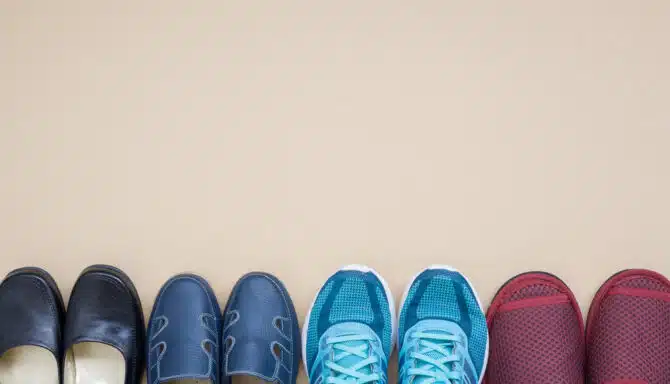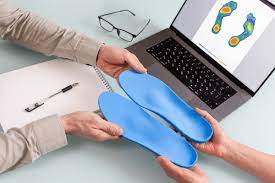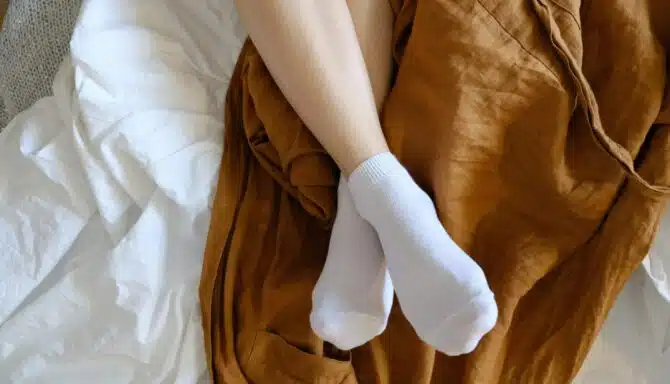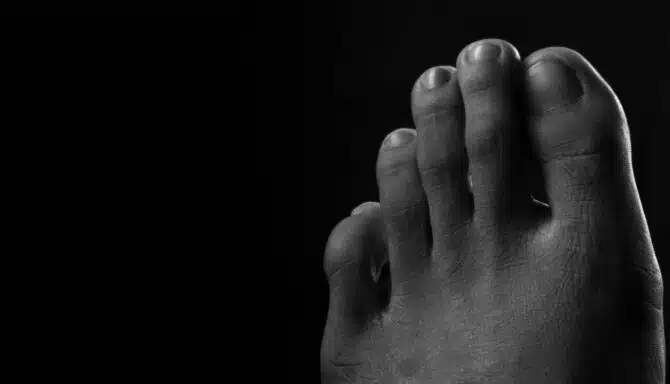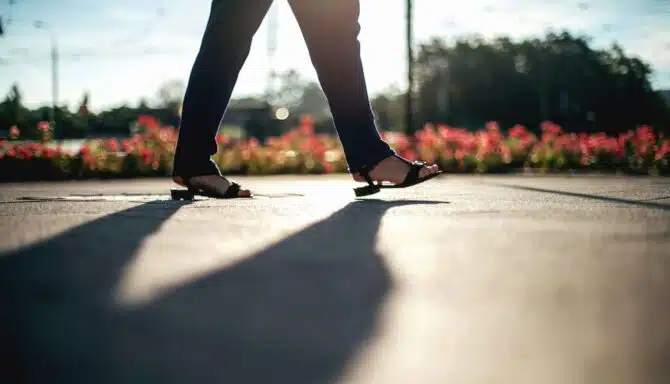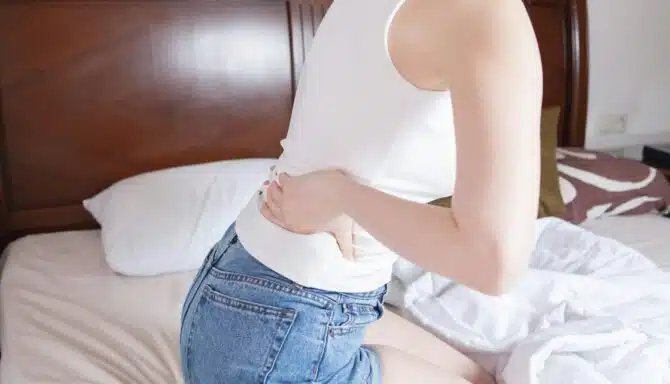October 21, 2024
Selecting the best footwear for foot health is an often overlooked part of self care. The right shoes not only get your feet from point A to B, but can also prevent various types of foot pain, like arch pain or heel pain. Better yet, solid shoe choices can shield your feet from some of the most frustrating chronic foot conditions. In this guide, we’ll walk you through the key features to look for in supportive shoes and why these elements matter for healthy feet.
Arch Support
Arch support is key for foot pain prevention and daily comfort. This feature helps position the foot in a healthy arch alignment so it can support your body weight more evenly. Studies show this is extra helpful for people with flat feet and high arches— essentially creating the normal arch they need. Lack of proper arch support can lead to conditions like plantar fasciitis. Arch support in shoes typically looks like a raised, curved section along the inner part of the insole.
Shock Absorption
Shock absorption is a must-have for athletes, long walk lovers, or those who work on their feet, like servers or construction workers.
It's essentially cushioning that keeps the harsh effects of the pavement, floor, trails and more from damaging your joints. This is especially important for people with conditions like arthritis or heel spurs. Supportive shoes with adequate shock absorption use materials like EVA foam or cork to cushion the foot, thereby minimizing strain on the feet, ankles, knees, and lower back. Click here to learn more about it!
Grip
Is fall prevention important to you? If yes, make sure you buy non-slip shoes or shoes with a solid-grip outsole.
A firm grip is vital for healthy feet because it reduces the risk of sprains or fractures. It should work on various surfaces, from slick sidewalks to gravel paths. Older people with balance issues should ensure their shoes have this crucial feature.
Waterproofing and Breathable Materials
Waterproof shoes (such as shoes made with GORE-TEX fabric) keep your feet dry in wet conditions, reducing the risk of fungal infections and blisters. Likewise, breathable fabrics with perforation in the shoe’s upper promotes air circulation, which is a top-priority feature for many athletes at the gym. That said, choosing the right materials can make a significant difference in comfort and hygiene for everyone, not just athletes.
Removable Footbeds
It may seem counterintuitive to buy a shoe that has something you don’t need, but hear us out! The best footwear for foot health typically have them!
Shoes with removable footbeds offer customization options for those who need orthotics or insoles from brands like Superfeet. From pregnancy to diabetes, many conditions require this shoe perk.
This feature may also make it easier to keep your shoes clean, or even extend their lifespan since you aren’t using its original footbed as often.
September 26, 2024
Orthotics are supportive, custom devices designed to improve the alignment and function of the feet, ankles, and lower limbs. They aim to address specific issues like flat feet, overpronation, or arch support. This can help alleviate discomfort and prevent injuries by redistributing pressure and correcting abnormal movement patterns. Adequately fitted orthotics can significantly enhance comfort and mobility, making daily activities more manageable and pain-free.
Custom orthotics can make a big difference, but how exactly do orthotics correct foot alignment? And how do they work? Let's explain.
What are orthotics?
Orthotics are specialized, custom-designed insoles that you place inside your shoes. They come in many forms, and are molded and constructed specific to your unique foot needs. Their main job is to support and correct the alignment of your feet, which can help address various foot and lower limb issues. They essentially promote healthy biomechanics to ensure your body moves the way it's designed to.
Orthotics are custom-made specifically for your feet by a chiropodist (foot specialist). The chiropodist will do a biomechanical and gait analysis, and then take a mold of your foot (typically with a 3D digital scanner). The chiropodist then custom-designs the orthotics according to your specific needs, and a lab then constructs the orthotics according to the chiropodist's instructions.
It's important to note that while orthotics can be beneficial, they may not be suitable for everyone and can have some drawbacks, such as initial discomfort and the need for regular maintenance. Custom orthotics are more expensive than over-the-counter options, but they are an investment in your future — they may allow you to avoid more severe issues and chronic pain long-term, and can address foot concerns that over-the-counter insoles cannot. Not to mention, they are longer-lasting.
How orthotics correct foot alignment?
Orthotics are meant to modify how your foot moves and distributes pressure. They can help with several conditions, including:
Flat feet: Orthotics can support fallen arches to maintain and prop up the natural contours of your foot.
High arches: When you have high arches, excessive pressure is placed over a very small area of your foot. Orthotics help by cushioning and distributing pressure more evenly. If pressure is unevenly distributed across your feet, you're at a higher risk of overworking neighbouring parts of your foot.
Overpronation: If your feet roll inward too much when you walk or run (called "overpronation), orthotics can help correct this movement. They do this by creating a barrier to your foot's inward movement, which corrects the overpronation. (Interesting fact: people with flat feet are prone to overpronation, so the treatment for the two conditions is often the same).
Heel pain: Orthotics can reduce the strain on the plantar fascia and help alleviate heel pain.
By correcting foot alignment, orthotics can provide significant relief from pain and prevent future issues. The feet are our body's foundation, so when your feet are moving properly, it helps the rest of our body move properly. That allows muscles and joints to work the way they were designed to without being over-stressed. This then helps reduce pain - not only in our feet, but the rest of our body too!
Types of orthotics
There are many different types of orthotics designed for different footwear and activities. Click here to learn more!
Benefits beyond pain relief
Orthotics don't just help with pain—they can also play a proactive role in enhancing overall foot and body health. Proper alignment can lead to better posture, reduced knee and hip stress, and improved gait. Athletes often use orthotics to boost performance by optimizing foot mechanics, which then reduces the strain on the rest of their joints.
How to choose the right orthotics
If you're considering orthotics, here's what to keep in mind:
Consult a professional: A chiropodist can help determine if you need custom orthotics through a biomechanical assessment. They can then prescribe, design and fit your orthotics based on your activities and specific foot concerns. A chiropodist may also recommend footwear and over-the-insole options to test out first before going the custom route.
Consider your activities: Choose orthotics that match your lifestyle. For instance, if you're a runner, look for ones designed to absorb shock and provide stability. If you work in a setting with a formal dress code, you may want to opt for slimmer dress orthotics that will fit into your dress shoes.
Look at the full picture: Orthotics alone likely won't solve all your foot concerns. They're just part of the equation. You'll also want to ensure your wearing proper footwear and maintaining an active, healthy lifestyle. If you have chronic pain or a conditions like arthritis, regular exercise and stretching is very important to build strength in your feet and ankles. Orthotics are essentially meant to supplement a healthy lifestyle - not substitute it.
How to get the most out of your orthotics
Once you have your orthotics, wear them regularly to see the best results. They take some time to get used to, so gradually increase the time you wear them daily. Also, remember that orthotics are just one part of foot health—maintaining a proper exercise routine and suitable footwear are equally important. To ensure the longevity of your orthotics, clean them regularly and follow any specific care instructions provided by the manufacturer or your chiropodist.
September 12, 2024
Looking to end your stint with foot arch pain? You've come to the right place. This post explores different kinds of arch pain, what causes it, and our top tips for foot arch pain relief.
Plantar fasciitis
Plantar fasciitis occurs when the plantar fascia (the thick band of tissue running along the bottom of your foot) becomes inflamed. It typically causes sharp pain in the heel and arch, especially in the morning or after periods of rest.
Cause: Repeated stress on the feet, especially from high-impact activities, can strain the arch and lead to pain. Increased body weight can also stress the feet more, leading to arch pain and discomfort. Finally, shoes lacking adequate arch support or cushioning and poorly fitted shoes can exacerbate foot pain.
How to alleviate pain: Rest, recovery and ice are the first things you should do to alleviate plantar fasciitis. The next step is to invest in footwear with proper arch support and cushioning. You can also upgrade your existing footwear with insoles or orthotic inserts designed for arch support. Custom orthotics help redistribute pressure in your foot and reduce strain on the arch. Stretching exercises for the Achilles tendon and plantar fascia can also reduce inflammation and arch pain associated with plantar fasciitis..
High arches
People with high arches often experience discomfort in the arch and heel due to insufficient shock absorption. This condition can lead to an imbalance in foot mechanics, causing pain in various parts of the foot.
Cause: Genetic factors can play a role in high arches.
How to alleviate pain: Cushioned, supportive shoes and insoles can help manage arch pain associated with high arches. Look for footwear with ample cushioning and arch support to alleviate discomfort.
Flat feet
Also known as fallen arches, flat feet affects the arch's ability to properly support a person's body weight, which then leads to arch pain. Flat feet can cause many biomechanical issues, which can lead to overpronation (where the foot rolls inward excessively), plantar fasciitis, and many other foot conditions, all of which contribute to foot and ankle pain.
Cause: Like high arches, genetic factors can play a role in flat feet. Flat feet can predispose individuals to certain types of foot pain.
How to alleviate pain: Proper arch support is key for foot arch pain relief. People with flat feet should look for stability shoes. These shoes are specially designed to correct overpronation and properly support the arch. Custom orthotics can also significantly support fallen arches. They're tailored to your foot's needs and help improve alignment and pain. You can get custom orthotics at our foot clinic by booking an Orthotic Assessment appointment with one of our licensed chiropodists.
July 18, 2024
Feet come in all shapes and sizes, and while many people have heard of common foot conditions like bunions or flat feet, there's another lesser-known but equally interesting foot characteristic called Morton's foot or Morton's toe.
The condition occurs when the second toe is longer than the big toe, leading to potential biomechanical implications and foot-related issues. Let's delve into Morton's Foot, its potential effects on foot health, and how to manage it.
What is Morton's foot/toe?
Morton's Foot, also known as Morton's toe/foot or Greek foot, is a foot structure in which the second toe is longer than the big toe. The big toe is the longest in a typical foot, followed by the second toe. (Despite sharing the same name, Morton's neuroma and Morton's toe are not the same.)
However, in individuals with Morton's foot, the second toe extends beyond the big toe, sometimes significantly. The condition is quite common. As many as 40%+ individuals have a longer second toe than a big toe.
Potential biomechanical implications
But here's the twist: while Morton's foot is generally considered a variation of normal foot anatomy rather than a medical condition, it can have some surprising biomechanical implications that affect gait and foot function. Let's explore these potential issues associated with Morton's foot.
Added pressure on the second toe
The longer second toe may bear more weight during walking or standing, leading to increased pressure and potential discomfort or pain in the ball of the foot, which may contribute to clawing of the toe and hammertoes.
Gait changes
Morton's foot can alter the distribution of weight and pressure across the foot, potentially affecting gait mechanics and posture. This may contribute to overpronation, increasing the risk of injuries such as plantar fasciitis, shin splints and bunions.
Footwear challenges
Finding the right footwear can be a real challenge for individuals with Morton's foot. Shoes often fail to comfortably accommodate the longer second toe, leading to issues such as rubbing, irritation, or the development of thickened or ingrown toenails, corns or calluses on the affected toe.
How to manage Morton's foot
While Morton's Foot may not require medical intervention, there are steps individuals can take to manage associated discomfort or mitigate potential issues proactively:
Choose footwear wisely. Opt for shoes with a wide toe box to comfortably accommodate the longer second toe—Asics is a great choice for a roomier and wider toe box. Avoid narrow or pointed shoes that can squeeze or crowd the toes.
Consider orthotic support. Custom orthotic inserts or insoles can offset pressure on the toes and support the foot. This can alleviate any discomfort associated with Morton's Foot and improve your overall foot mechanics.
Foot-strengthening exercises. Engaging in exercises to strengthen the muscles of the foot and ankle can help improve stability and support, reducing the risk of overuse injuries or discomfort associated with Morton's foot.
Regular foot care. Practicing good foot hygiene and monitoring for signs of irritation or injury can help prevent complications such as corns, calluses, or ingrown toenails on the longer second toe.
May 20, 2024
As the temperatures rise and the sun shines brighter, it's time to ditch the closed-toe shoes and slide into something more comfortable and breathable. Yes, it's sandal season! But with so many options available, how do you choose the best sandals for your summer adventures? We've got you covered.
In this guide, we'll explore the essential features to look for in summer sandals and introduce you to some top picks that seamlessly blend style with comfort.
Cork footbed
One key feature to consider when selecting summer sandals is the footbed material. Cork footbeds are famous for their ability to mould to the shape of your foot over time, providing personalized support and cushioning.
Additionally, cork is lightweight and absorbs shock, making it an excellent option for all-day wear. Whether strolling along the boardwalk or exploring a new city, sandals with cork footbeds ensure your feet stay comfortable and supported.
Arch support
Arch support is essential, especially if you plan on wearing your sandals for extended periods. It distributes weight across your feet, reducing strain and preventing discomfort. A lack of arch and forefoot support can lead to foot problems like plantar fasciitis or metatarsalgia.
Look for sandals with arch support or removable insoles. You can customize the level of support to your liking. Your feet will thank you after a long day of sightseeing or outdoor activities.
Backstraps for support
While slip-on sandals are convenient, they may provide a different level of support and stability than those with backstraps.
Backstraps help secure the sandals to your feet, preventing them from slipping and sliding with each step. Added stability is particularly beneficial if you plan to engage in more active pursuits or tend to pronate or supinate. Backstraps come in various styles, from adjustable buckles to elasticized bands, allowing you to find the perfect fit for your feet.
Our top picks
Now that we've covered the essential features to look for in summer sandals let's introduce you to some top picks that effortlessly combine style with comfort.
NAOT Cornet and NAOT Castelo
Best for cork footbeds
With their contoured cork footbeds and adjustable backstraps, NAOT sandals offer exceptional comfort and support. The NAOT Cornet and NAOT Castelo styles feature chic designs that transition seamlessly from day to night.
Mephisto Hester and Mephisto Hetty
Best for cork footbeds
Mephisto sandals are renowned for their superior craftsmanship and comfort technology. The Mephisto Hester and Mephisto Hetty models boast cushioned footbeds with arch support and durable backstraps for added stability.
Aetrex Jess
Best for arch support
The Aetrex Jess sandals feature a built-in Lynco orthotic footbed for maximum support and alignment. The adjustable backstrap ensures a secure fit, making them ideal for all-day wear.
NAOT Enid and NAOT Amadora
Best for backstrap support
NAOT offers a range of stylish sandals with cork footbeds and backstrap designs. The NAOT Enid and NAOT Amadora are built with quality and comfort in mind. The three variations three are perfect for summer adventures.
Mephisto Norine
Best for backstrap support
The Mephisto Norrine sandals combine elegance with functionality. Featuring Soft-Air technology and adjustable straps, they provide unparalleled comfort and support for any occasion.
April 8, 2024
Back pain is common among adults, with up to 80% of people experiencing back pain at least once in their lifetime. While the causes of back pain can vary, one often overlooked factor is the type of footwear we wear. Believe it or not, the shoes we put on our feet can significantly impact our spinal health.
This article will explore the connection between footwear and back pain and provide insights into choosing shoes to support a healthy back.
The alignment connection
Our feet are the foundation of our body's alignment, and our shoes play a crucial role in maintaining proper alignment from the ground up. When we wear shoes with inadequate support or that don't fit properly, it can throw off the alignment of our feet, leading to a chain reaction of misalignment throughout the body, including the spine. This misalignment can cause strain on the muscles and ligaments of the back, leading to discomfort and pain.
High heels and back pain
One of the most well-known culprits of back pain is high heels. While they may be fashionable, high heels can wreak havoc on the spine. The elevated heel alters the spine's natural curvature, increasing pressure on the lower back and making the muscles to work harder to maintain balance. Over time, this can lead to muscle imbalances, postural issues, and chronic back pain.
Flat shoes and lack of support
Conversely, flat shoes with inadequate support can also contribute to back pain. Shoes that lack proper arch support don't provide necessary shock absorption and stability, leading to increased stress on the spine.
Additionally, shoes with worn-out soles or insufficient cushioning can exacerbate back pain by failing to provide adequate protection against impact forces.
Choosing the right footwear
So, what can we do to prevent back pain and promote spinal health through our footwear choices? Here are some tips for selecting the right shoes:
Opt for shoes with adequate arch support to maintain the spine's natural curvature.
Look for cushioned soles that provide shock absorption to reduce impact on the spine.
Choose shoes with a supportive heel counter to stabilize the foot and ankle.
Ensure proper fit by wearing shoes and walking around to assess comfort and support.
Consider orthotic inserts or custom-made orthotics to address specific foot issues and improve overall alignment.
When it comes to back pain, every step counts. By paying attention to our shoes and choosing footwear that supports spinal health, we can take proactive steps to prevent discomfort and promote overall well-being.
